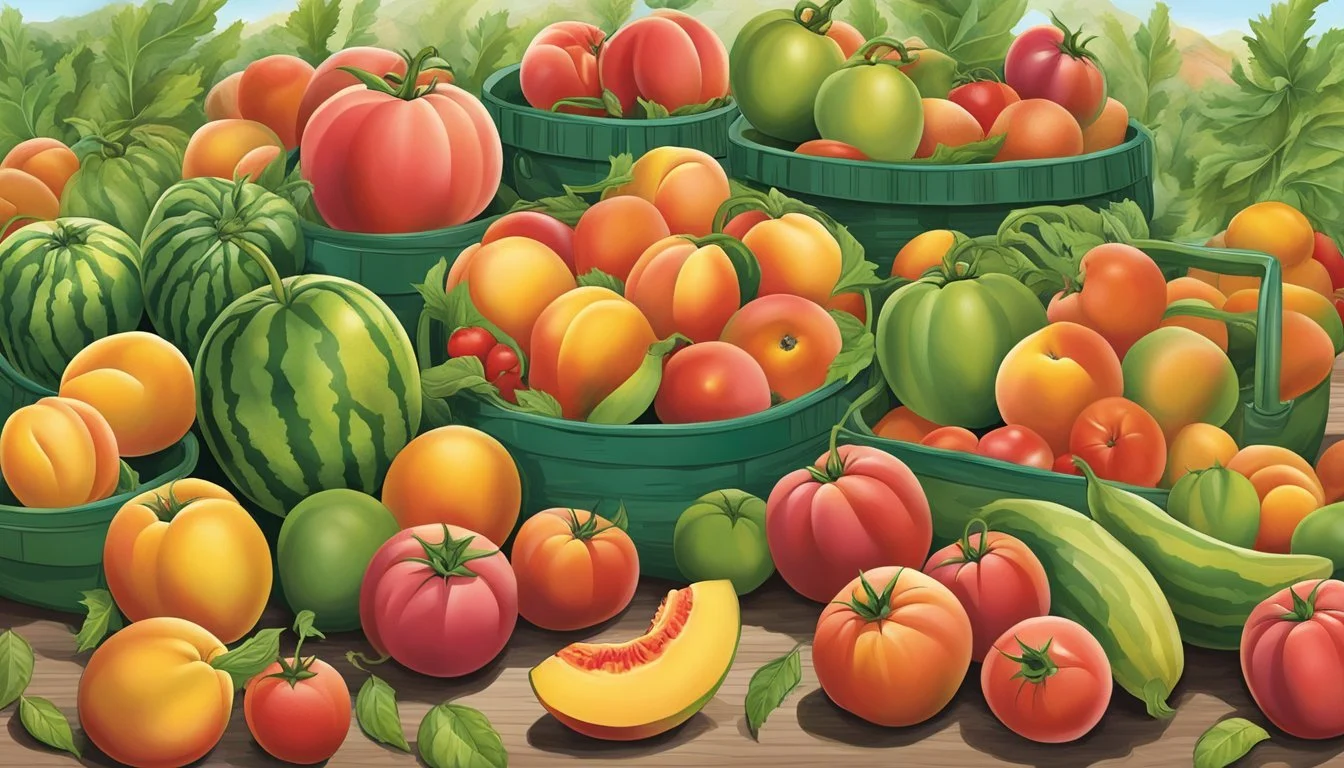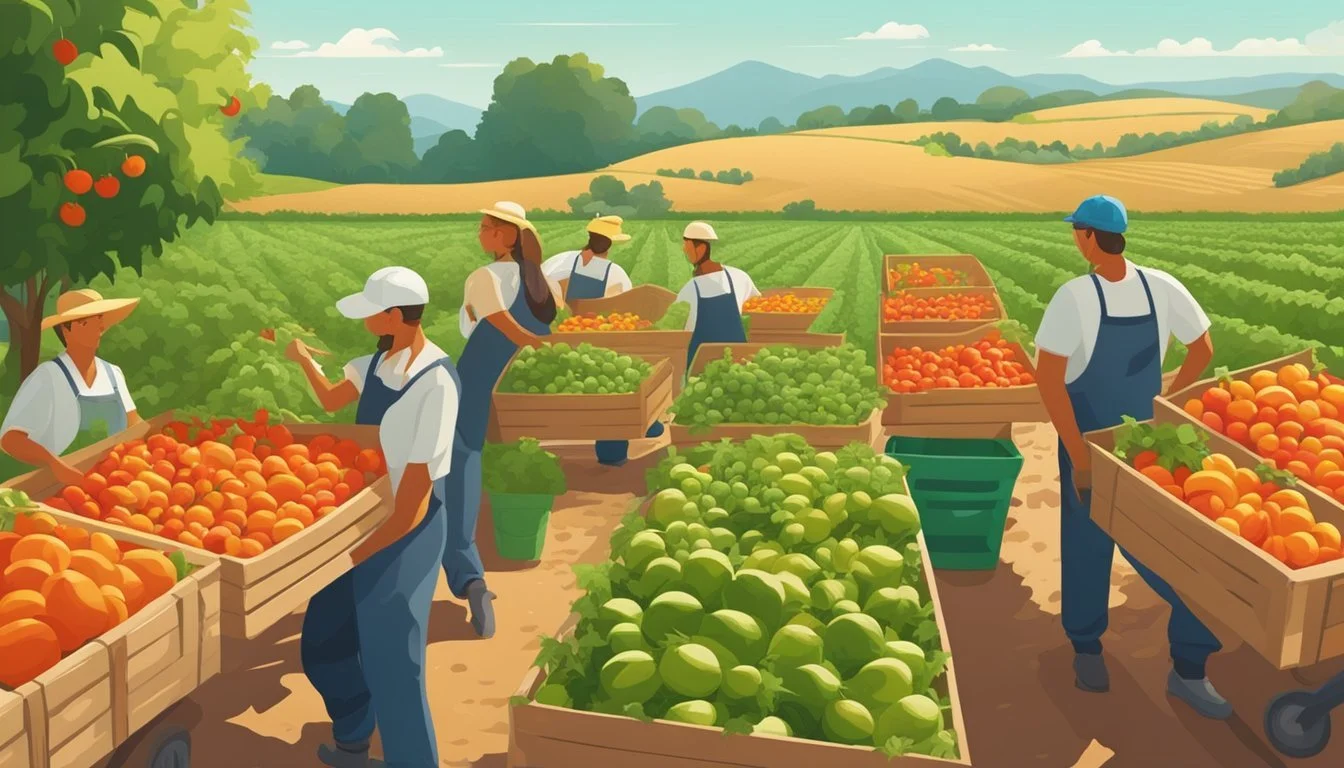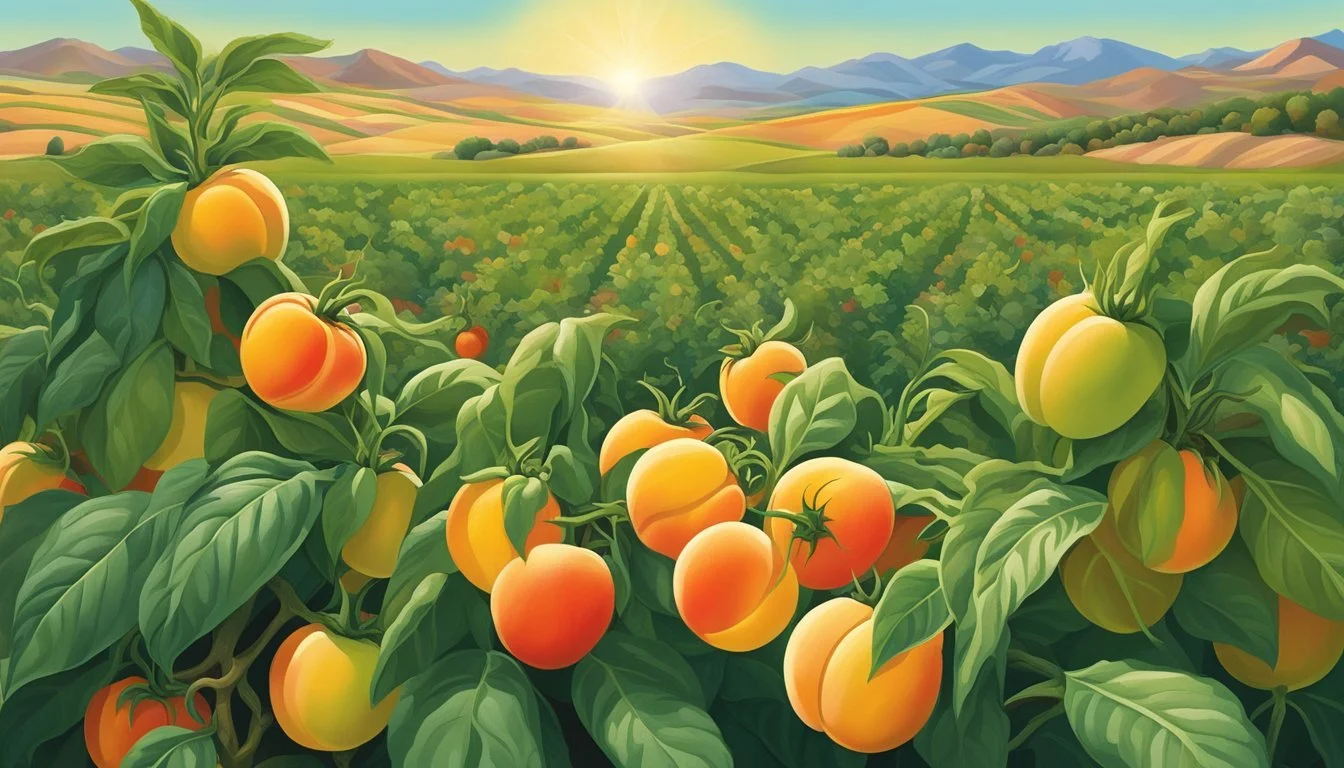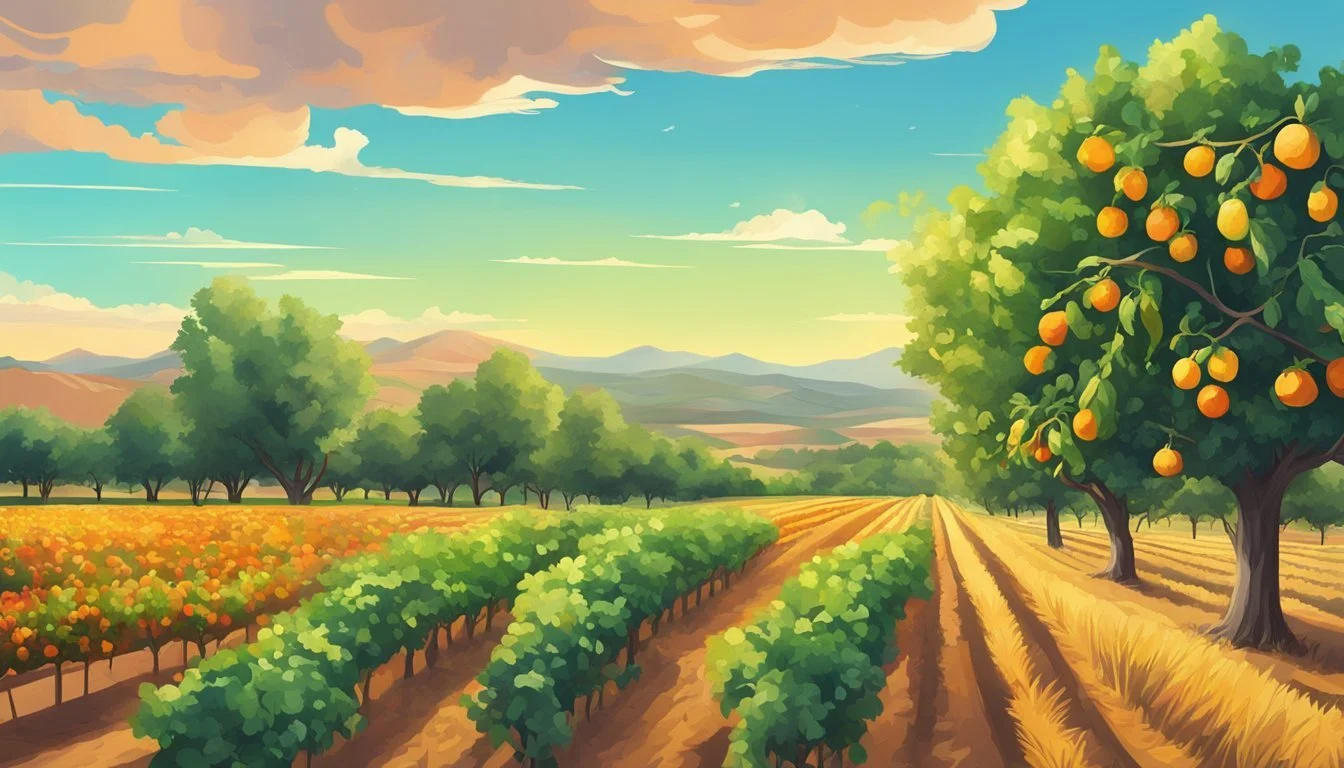New Mexico Seasonal Fruit & Vegetables in August
Your Guide to Fresh Produce
This Article is Part of our New Mexico Seasonal Fruit & Veg Calendar
August in New Mexico offers a vibrant palette of produce, with the height of summer bringing a bountiful array of fruits and vegetables to local markets and roadside stands. As the warm, sunny days prevail across the state's diverse growing regions, an assortment of colorful and nutritious seasonal offerings become available to consumers. This period marks a time when the selection is abundant, and the flavors are at their peak freshness.
The warm New Mexico climate and long summer days create an ideal environment for growing a variety of fruits such as peaches, melons, and berries, while vegetables like corn, tomatoes (What wine goes well with tomatoes?), and chile peppers thrive in the August heat. The agricultural richness of the state is on full display during this month, with farmers' markets and community-supported agriculture programs providing a platform for the local produce to shine.
Shoppers seeking the freshest possible options can enjoy the harvest from New Mexico's farms, where the commitment to sustainable and seasonal farming practices ensures that the produce not only supports local economies but also offers a richer, more robust flavor profile. The availability of such produce makes August an excellent time for residents and visitors to experience the true taste of New Mexico's seasonal bounty.
Understanding New Mexico's Growing Season
New Mexico's vast landscape provides a unique agricultural canvas that plays out across its varied climate zones. Summer months, particularly from May through September, mark a bustling growing season for the state. The climatic range includes dry to semi-arid areas, alongside regions with continental and even alpine weather patterns.
In the heart of the summer, June through August, the state experiences its peak harvest time. These months are critical for both gardening enthusiasts and commercial agricultural operations. July and August are especially important as many fruits and vegetables reach their optimum ripeness.
For gardeners, understanding the state's climate is essential for a successful harvest. The New Mexico summer provides an amenable environment for a plethora of crops:
Fruits: Such as peaches and melons.
Vegetables: Including tomatoes, chilies, and sweet peppers.
While some regions may see a longer growing season due to milder temperatures, the majority of the state operates within this summertime window. It's a period that requires careful planning that usually begins as early as April, when initial planting can take place, and extends to the harvesting of late bloomers in September.
Month Activity April-May Start of planting season June-July Growth and ongoing maintenance August Peak harvest September Late harvest and preparation
Adapting to New Mexico's unique growing conditions is paramount for a bountiful yield. Farmers and gardeners alike invest their efforts during these warmer months, making the most of the long days and nutrient-rich soil to nurture their crops to fruition.
Seasonal Produce Calendar for New Mexico
In New Mexico, August marks the peak of summer with a diverse array of fresh fruits and vegetables ready for harvest. The produce guide for this month includes a variety of options that are at their most flavorful.
Summer Fruits
Peaches: Juicy and ripe, peaches are in full swing in August.
Melons: Watermelons and cantaloupes (how long does cantaloupe last?) offer sweet, hydrating refreshment.
Apples: Early varieties of apples like Gala begin to reach maturity.
Berries: While nearing the end of their season, raspberries can still be found fresh.
Summer Vegetables
Tomatoes: Vibrant and flavorful, tomatoes are a staple in August.
Chiles: Synonymous with New Mexican cuisine, green chiles are freshly picked.
Corn: Sweet corn is abundant and at its peak sweetness.
Squash: Both summer squash and zucchini are readily available.
Green Beans: Crisp and tender, green beans are perfect for picking.
Key Fruit & Vegetable Harvests in August
In New Mexico, August is a bountiful month with an array of fruit and vegetable harvests ripening under the warm summer sun.
Fruits
New Mexico's August heat cultivates a sweet array of fruits. Peaches are abundant, offering juicy and flavorful selections at local markets. Raspberries also reach their peak, ready for picking, with their tart and sweet flavors. Melons, including watermelon and cantaloupe, are similarly in their prime, providing refreshing treats perfect for the season’s heat.
Vegetables
Abundant sunshine and warm days contribute to the flourishing of several vegetables during this period. Tomatoes burst with color and taste, ideal for both fresh salads and cooking. Green Beans are tender and plentiful, ready for harvesting. Eggplant (What wine goes well with eggplant?) enjoys the August warmth, becoming shiny and plump. Nutritional Corn is harvested during its sweetest stage, while Squash varieties add diversity to the local produce offerings. Peppers, ranging from sweet to fiery, are also ready for picking, enhancing the flavors of many seasonal dishes.
Preparing and Storing August Produce
August provides an abundance of fresh produce in New Mexico, each with specific storage and preparation needs to maintain flavor and freshness.
Storage Tips
Peaches: Store unripe peaches at room temperature until they yield to gentle pressure. Once ripe, refrigerate to prolong freshness.
Tomatoes: For the best flavor, store tomatoes at room temperature away from direct sunlight. Refrigeration is only recommended for extending freshness once they are fully ripe.
Green Beans: Keep green beans in a perforated plastic bag in the refrigerator crisper drawer to maintain crispness.
Melons: Store whole melons at room temperature. Refrigerate cut melons in an airtight container.
Eggplant (What wine goes well with eggplant?): Store eggplant unrefrigerated in a cool place if using soon, otherwise keep in the crisper drawer for short-term storage.
Peppers: Store fresh peppers in the vegetable drawer of the refrigerator in a plastic bag with holes for circulation.
Preparation Techniques
Peaches: Rinse gently just before eating or using in recipes; peeling is often optional based on the dish.
Tomatoes: Wash and cut tomatoes just before use to retain flavor and firmness. Cook at a moderate temperature to enhance sweetness and texture.
Green Beans: Rinse green beans thoroughly. Trim the ends, and they are ready for steaming, blanching, or sautéing.
Melons: Cut melons should have seeds removed, and the fruit can be sliced or cubed. Melon skin should be thoroughly washed before cutting to reduce the risk of contamination.
Eggplant: Rinse the eggplant and trim the stem before slicing or cubing. Salting the pieces before cooking can reduce bitterness.
Peppers: Wash peppers, then slice open to remove the stem, core, and seeds. They can be chopped, sliced, or stuffed and then either eaten raw or cooked.
Benefits of Eating Seasonally
Eating seasonally offers an array of benefits, both for personal health and the community at large. During the warmer months, especially in August, New Mexico's farms flourish with a bounty of fresh produce that supports a health-conscious lifestyle.
Flavor and Nutrition
Fruits and vegetables harvested during their peak season taste better. They are allowed to ripen fully in the sun, leading to greater flavor complexity and a sweeter profile, particularly in summer varieties. Nutrient content is also at its highest when produce is fresh. Vitally, iron—a crucial mineral for maintaining healthy blood cells—is more abundant in fresh, seasonal foods like leafy greens.
Enhanced Flavor:
Fruits and vegetables possess a richer taste when in season.
Optimal Nutrition:
Higher levels of vitamins and minerals, including iron.
Supporting Local Farms
Seasonal eating fosters a connection with local farms, which typically offer the most recent harvest. This connection helps sustain local agriculture and stimulates the local economy.
Community Support:
Local farms benefit from the patronage of seasonal eaters.
Economic Impact:
Dollars spent locally cycle back into the community.
Health and Sustainability
Consuming seasonal produce contributes to a varied diet, which is linked to health improvements, such as reduced risk of some cancers. It is also an environmentally sustainable practice. Seasonal eating reduces the carbon footprint associated with long-distance food transport.
Diverse Diet:
Introduces a variety of fruits and vegetables into meals.
Environmental Impact:
Lower carbon footprint compared to out-of-season produce shipping.
In summary, seasonal eating in August accentuates the enjoyment of summer's fresh flavors, maximizes the intake of essential nutrients like iron, supports local farmers, and contributes to a healthier planet.
Challenges for New Mexico Growers
New Mexico's agriculture sector faces unique challenges owing to its varied climates, which range from arid deserts to snow-capped mountains. Growers must tackle issues pertaining to pests, diseases, and climate-related stresses.
Pests & Diseases
Farmers in New Mexico contend with a variety of pests and diseases that can affect crop yield and quality. Some common pests include the corn earworm, the onion thrip, and the squash bug. Effective pest management can be difficult due to the state's vast topographical diversity. For instance, the corn earworm thrives in warmer conditions, posing a higher risk in the southern regions of the state.
Diseases prevalent in New Mexico's vegetable crops include:
Powdery mildew, which affects crops like squash and cucumbers.
Curly top virus, which is transmitted by the beet leafhopper and can devastate tomato plants.
Given the potential for significant crop loss, farmers must continuously monitor and implement integrated pest management strategies, which require knowledge of both pest biology and sustainable control tactics.
Climate Considerations
Temperature Extremes: New Mexico gardeners often have to manage the impacts of temperature extremes, given that the state falls within several hardiness zones, ranging from 4b through 9a. Summer months can be particularly arduous, with high temperatures that may inhibit pollination and lead to poor vegetable development.
Water Scarcity: Inadequate rainfall and diminishing water sources add another layer of complexity to farming in New Mexico. Irrigation is typically necessary, but it must be managed carefully to prevent both water waste and crop stress.
Variable Weather Patterns: Sudden weather shifts, which are not uncommon in the region, also present challenges. Hail, early frost, or prolonged heat waves can abruptly damage or destroy crops.
Farmers must remain vigilant and employ strategies such as mulching to conserve moisture, using shade cloth to mitigate heat stress, and installing protective structures against frost and hail.
Local Agriculture and Community Impact
Local agriculture in New Mexico has a significant impact on communities, directly influencing the local economy and promoting sustainable practices through farmers' markets and community-supported agriculture programs.
Farmers' Markets
New Mexico celebrates local food producers at various farmers' markets throughout the state, particularly during events such as LocalFoodConnectsNM Month in August and National Farmers Market Week. These markets are not only key points for community gatherings but also vital for the state's agricultural economy, allowing local farmers to sell their produce directly to consumers. Markets like these typically support an array of local farms, boosting sales and providing residents with access to fresh, seasonal fruits and vegetables.
Economic Contribution: Direct income for farmers, job creation
Community Benefits: Fosters local engagement, ensures access to nutritious food
Community Supported Agriculture (CSA)
In alignment with the sustainable approach, CSAs in New Mexico like Matt's Mushroom Farm and Schwebach Farm offer weekly produce boxes to subscribers. These direct-to-consumer relationships bolster support for local farms and play a critical role in sustaining the local agricultural sector. Subscribers to CSAs typically receive a selection of in-season produce, sharing both the risks and benefits of farming with their local producers.
Seasonal Shares: May through October, fresh mushrooms year-round
Local Impact: Underpins farm financial stability, encourages local food production
By investing in local agriculture through farmers' markets and CSA programs, New Mexico not only promotes sustainable farming practices but also strengthens community bonds and supports a thriving local economy.








